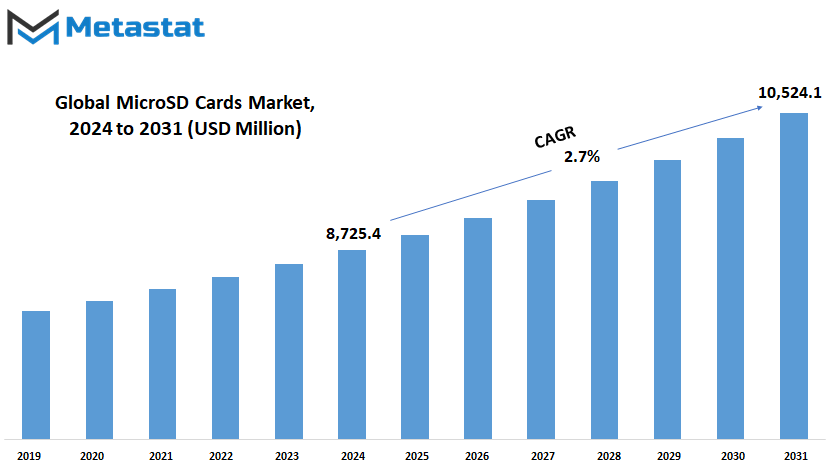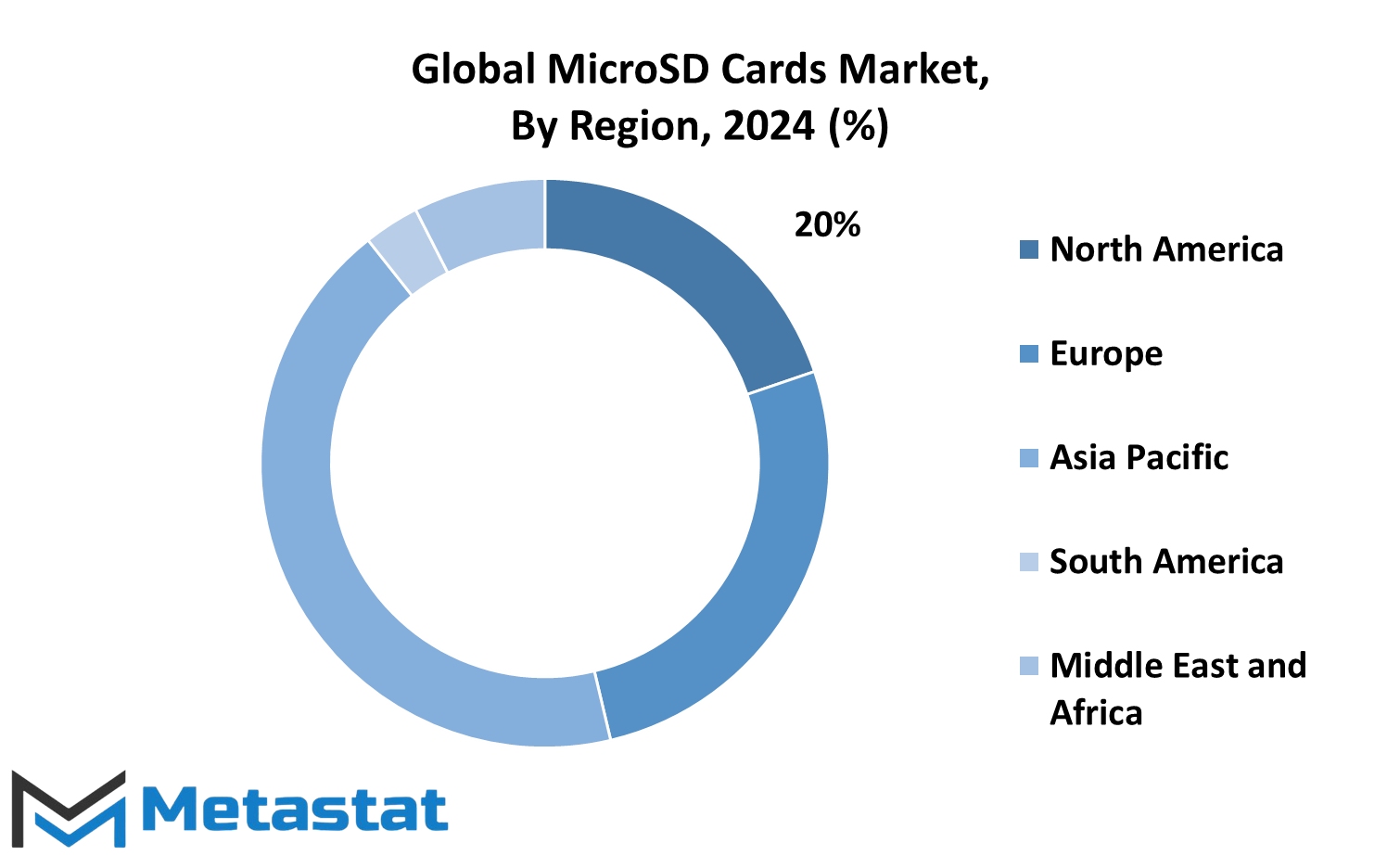MARKET OVERVIEW
The global microSD cards market forms a major share of the electronics industry specializing in compact, high-capacity storage solutions for various devices. MicroSD cards are projected to be one of the prime movers in future landscapes that relate to storage, adjusting with technological advancement and consumer needs.
Given that they are so small in size and versatile, in a few more years, microSD cards will be applied to a wide array of domains, from smartphones, tablets, and cameras to a range of diverse IoT devices. This flexibility guarantees that the Global MicroSD Cards market will always retain broad, strong appeal among manufacturers and consumers of technology products. In this light, MicroSD cards are expected to further evolve, remaining up-to-date in order to meet the continuously increasing demand of devices on higher storage capacity and faster data transfer rates, thus assuring excellent performance and reliability.
Most likely, future developments in the Global MicroSD Cards market will be in the line of increasing storage capacities while guaranteeing compatibility with emerging technologies. Expected developments in the market include card speed and enhancements in data security features. Flash memory technology could provide improvements in MicroSD cards with read and write speeds to cater to high-definition video recording and large-scale data storage applications.
Consumer trends are most likely to drive demand in the global MicroSD cards market, with growing use of high-resolution cameras and mobile devices pushing demand up the curve for larger storage capacities. As more devices become capable of handling and processing large amounts of data, so also will the requirement for high-performance storage solutions increase. Manufacturers will probably respond to this demand by investing in research and development to come up with MicroSD cards that can meet the new requirements while remaining relevant to technology-conscious consumers.
Moreover, the growth in applications of smart technology is most likely to benefit the Global MicroSD Cards market. With increasing instances of smart devices, they are bound to generate a higher volume of data that will require reliable storage options—none other than microSD cards.
Another growth driver for the Global MicroSD Cards market will be the increasing focus on data security. It is assumed that, in the future, MicroSD cards will embed advanced encryption and security techniques to protect users' information from various rising concerns about data privacy and protection. The manufacturers will focus on these features to meet consumer expectations and regulatory requirements.
Geographically, it will be very different growth seen in the Global MicroSD Cards market. Contribution to the expansion of the market is likely to come more from emerging markets where consumer electronics are on a verge of expanding their sectors. As these regions continue developing technologically, adoption of MicroSD cards is expected to rise, further fueling the growth of the market.
With changing technology and consumers' needs, Global MicroSD Cards will evolve continuously. Innovations that are likely to be adopted to meet the increasing demand for efficient data management solutions include better storage capacity, increased speed, and enhanced security. With the ever-expanding smart technology and correspondingly ever-increasing demand for high-performance storage, MicroSD cards are likely to remain relevant and important in the electronics industry.
Global MicroSD Cards market is estimated to reach $10,524.1 Million by 2031; growing at a CAGR of 2.7% from 2024 to 2031.

GROWTH FACTORS
The Global MicroSD Cards market is likely to expand at a humongous extent, driven by several growth factors. With technology evolving at a rapid pace, the growing demand from mobile devices for higher capacity of storage continues to flourish. That's increased sophistication of smartphones, tablets, cameras, and other portable devices grows, analogous to data, applications, and media files that need bigger solutions for storage. The demand will undoubtedly give a push to the growth of MicroSD cards.
Improvements in transfer speed and storage capacity are some of the major driving forces behind the market. Continuously evolving MicroSD card technology has increased the data transfer rate to a very impressive level for any customer looking forward to accessing heavy data in no time. Such progress will help people who value efficiency and speed—be it for personal or professional purposes—to access information in a very short time. It improves demand for MicroSD cards further as faster network speeds require more robust storage solutions to keep up with an increase in data consumption.
With so many promising factors for growth, there are some challenges pertaining that can further restrict the expansion of global MicroSD cards market. One of the major challenges to the market is the increasing popularity of cloud storage services. As more and more people and businesses begin to utilize cloud solutions, there may be less of a demand for actual storage devices like MicroSD cards. Cloud storage can be spread across any device with an internet connection—something that might prove to be appealing to many users who value convenience and management of their data remotely.
Concerns over data theft and loss also put a leash on the market. Consumers are well aware of the risk of having sensitive information saved on a tangible device. These perils of data thefts or loss of personal or professional information can deter some people from using the MicroSD cards altogether. The security concerns can be further strengthened by adding more encryptions and coverages that further reduce this issue and MicroSD cards may persist to carry on.
On the other hand, the proliferation of IoT devices and smart gadgets creates major opportunities for the Global MicroSD Cards market. With the increased count of connected devices comes increased demand for compact, effective, and feasible storage solutions. MicroSD cards provide the much-needed flexibility and capacity to back up connected devices with their data requirements; therefore, they become an integral part of this fast-growing IoT ecosystem. Market growth will further augment the integration of MicroSD cards with smart home systems, wearable technology, and industrial IoT applications.
The future Global MicroSD Cards market will be transformed by changing consumer needs and technology. Manufacturers, moving ahead from raising storage capacities to higher data transfer speeds and advanced security features, are well on the way to riding the wave for high-performance storage solutions. Its ability to move with the dynamics of digital storage applications in the near future will therefore no doubt come to define the success for this market while serving traditional uses and keeping up with emerging technologies.
MARKET SEGMENTATION
By Type
The Global MicroSD Cards market is about to take up many developments in the course of time as technology is evolving. The MicroSD cards are small and versatile; they have become a must to extend the memory of equipment and gadgets like smartphones, tablets, cameras, and other electronic devices. The segmentation of the market by type into SD, SDHC, and SDXC allows consumers to decide according to intended usage and required capacity for the device, which is surely going to move ahead in the future.
These SD cards, whose capacity ranged from 8 megabytes to 2 gigabytes, were quite useful for simple storage. By today's criteria, their capacity is actually small, although it still does its fundamental functions on units that do not demand large storage spaces. According to technology innovators, these cards will remain relevant by providing cost-friendly and reverse compatibility functions on simpler gadgets. On the other hand, the SDHC cards provide 2 to 32 gigabytes of storage. These have gained the most significant amount of popularity since this midrange balance of storage and cost is very captivating. With the ever-increasing demand for high definition content and applications, SDHC cards will no doubt stay very popular among those who want to have medium storage capacity without spending too much money on it. This definitely will continue, mainly in markets where price is an important factor in customer choice.
On the other hand, SDXC cards are designed for those who would need even larger storage capacities of up to 32 gigabytes and a maximum of 400 gigabytes. Designed to capture high-resolution videos, accommodate large applications, and store huge amounts of data, such cards would make a niche for themselves. Given the increased demand for video recording in 4K and even 8K formats, SDXC cards are going to be quite common among professionals and enthusiasts alike. Thus, the growing trend of computing via the cloud and storage solutions online will not phase out physical storage options such as MicroSD cards; rather, these two entities will complement each other to ensure flexibility and redundancy in handling data for the user. MicroSD cards probably will further evolve for faster data transfer rates and security features in order to address growing consumer concerns about data privacy and protection.
The Global MicroSD Cards market looks forward to seeing innovations that will make the cards easier to use and increase their functionality in the near future. Manufacturers are most likely to develop cards concerning read and write speeds, which, hence, will help users dealing with huge files in everyday life. Also, improvements in the durability of the cards, like water resistance or temperature tolerance, will help to attract users who look for a reliable storage device in every kind of environment.
With constant updating to meet the dynamic consumer needs and innovations, the Global MicroSD Cards market is ready to continue its growth and transformation. Since different cards provide specific advantages, the market will always be diversified based on the kind of users it will appeal to, all the more establishing the fact that MicroSD cards are definitely here to stay in the world of digital storage. Growth in the market will be driven through innovation and consumer-oriented, connected improvements. It will meet the demand of an increasingly digital future.
By Application
The Global MicroSD Cards market is expected to grow manifold over the coming years, considering the technological developments and increasing consumer demand for portable storage solutions. Because of their compact size and high storage capacity, microSD cards become quite significant in many varied applications. With advancements in technology, their roles will also increase to engage a plethora of devices and purposes.
In the future, the MicroSD cards market will derive significant demand from smartphone users. With increasingly complex smartphones, for example, high-resolution cameras and advanced game playing, there will be a need for extra storage. MicroSD cards provide an easier way to extend the capacity of smartphones without sacrificing device performance, hence allowing users to store more photos, videos, and applications. This will eventually fuel demand as consumers look for ways to enhance their smartphone experience.
On the other hand, the growth of the Global MicroSD Cards market will spur the tablet PC segment. Tablets are finding growing acceptance in personal and professional use, truly being that middle ground between portability and functionality. As more and more businesses begin to use tablets for mobile workforce solutions and consumers for entertainment and productivity, so will the expandable storage needs. At this point, microSD cards will offer a great solution for people looking for flexibility in storing large files like presentations and multimedia content without their own personal cloud storage.
This increased demand will also be seen on the side of digital cameras for MicroSD cards. Improving camera technology requires advanced storage solutions that capture high-resolution images and record videos. MicroSD cards can provide the required speed and capacity to support professional-grade cameras, thus allowing photographers to capture and store large amounts of data. This trend will continue with the evolution of digital photography, and with that, the importance of MicroSD cards in the photography sector will only grow.
The role of MicroSD cards in the gaming console market will only increase. As more and more portable gaming consoles and mobile gaming start to become prevalent, so will the growing need for additional storage to carry a number of heavy game files and updates. MicroSD cards will provide gamers flexibility in expanding storage on their console so they can have huge access to a lot of games. As the gaming industry continues to grow, so will demand for MicroSD cards that will support the growth of the gaming console segment.
Outside of these key applications, there are a number of other areas wherein MicroSD cards would find utility. Continuing advancements in technology, new devices and newer applications shall come up that would eventually need better and efficient storage solutions, which will create opportunities for the Global MicroSD Cards market to expand into newer areas by driving innovation and growth.
The overall outlook of the Global MicroSD Cards market is very promising, with many factors driving it. As long as devices continue to get sophisticated and the consumer's yearning for more storage remains unabated, MicroSD cards will form one of the most essential components within the tech ecosystem. Catering to these changeable needs of the users through various applications, the market will continue to grow with new innovative solutions that enhance the digital experience.
|
Report Coverage |
Details |
|
Forecast Period |
2024-2031 |
|
Market Size in 2024 |
$8,725.4 million |
|
Market Size by 2031 |
$10,524.1 Million |
|
Growth Rate from 2024 to 2031 |
2.7% |
|
Base Year |
2022 |
|
Regions Covered |
North America, Europe, Asia-Pacific Green, South America, Middle East & Africa |
REGIONAL ANALYSIS
The Global MicroSD Cards market will continue to witness huge transformations as technological advancements come to propel demand and, therefore, competition. Adoption of smartphones and tablets is growing in North America; hence, this will be a major driver of the market's growth here. Key players within this region include the United States, Canada, and Mexico. With increasing digitalization, more consumers will require high-capacity storage solutions for these digital needs. Apart from that, the rise in high-definition video recording and gaming applications will further fuel the demand for MicroSD cards in North America.
In Europe, countries such as the UK, Germany, France, and Italy are going to contribute to the growth of the market. Demand for MicroSD cards will rise due to people seeking reliable storage options to preserve their memories, especially given the increased adoption of digital cameras and other types of electronic devices. Also, the flourishing gaming sector and multi-device use for entertainment and professional purposes will continuously fuel the demand for MicroSD cards in the region. A growing awareness of data security among European customers is also focusing the attention of manufacturers on enhanced security features across their cards.
Asia-Pacific is likely to dominate the market in Global MicroSD Cards, led by countries like China, India, Japan, and South Korea. This region's growth will be driven by growing smartphone penetration and expansion in the e-commerce sector. With more consumers going online within the Asia-Pacific regions to access the internet and digital content, so the demand for MicroSD cards grows. Besides, the region is exposing itself tremendously to rapid technological development and a rapidly increasing tech-savvy population, which further outruns the demand for more advanced storage solutions, such as MicroSD cards, with higher capacities and faster transfer speeds.
The outlook for South America in the MicroSD cards market will also be encouraging; it will be led by Brazil and Argentina. Demand for storage solutions in the region will grow due to growing usage of mobile phones and electronic gadgets. The more consumers use digital content, the more they demand high-capacity, reliable storage options. GCC countries, Egypt, and South Africa will be major growth contributors from the Middle East & Africa. Hence, the increasing smartphone penetration and consumption of digital content will drive demand for MicroSD cards in this region.
The market for Global MicroSD Cards will, in general, grow dynamically across different regions, with peculiar factors that would drive demand. In an increasingly changing technological landscape, manufacturers will have to remain focused on innovation and quality to meet up with changing consumer demand. Manufacturers of MicroSD cards will be better positioned to plunge into more advanced products with enhanced security features and large capacities in the future, again in response to the rising demands for digital storage solutions across the world.

COMPETITIVE PLAYERS
As technology rises, so does the consumer demand—indicating change in store for the Global MicroSD Cards market. This has been a very crucial market in sustaining the tech industry through many devices like smartphones, tablets, and cameras. A few main key players will help shape this market as it moves further into the future. These key players include top brands: SanDisk, Transcend Information, ADATA Technologies, Panasonic, and Kingston Technology. Thus, it was this passion for innovation and quality that helped drive the market into what it is today, and they will in turn shape important parts of its future development.
SanDisk, the most recognizable brand in storage, will hold its leading positions by introducing high-capacity and high-speed MicroSD cards. With a focus on developing such cards for scenarios relevant to content creators and tech enthusiasts, it is sure to keep pace in the market. Similarly, very rugged and reliable storage devices will make Transcend Information Corp. dear to consumers and professional users alike.
ADATA Technologies will never stop surprising the world with very advanced products, highly focusing on enhancing data transfer speeds and capacities of storage. Their creativity is, therefore, going to establish new standards within the industry. In the same light, Panasonic, together with Kingston Technology, will equally offer their versatile, high-performance MicroSD cards to fit various consumer needs.
Micron Technology and Sony will probably increase their market presence by collaborative working and integration of technology. As more devices become connected, smooth and flawless storage and transfer of data will be in growing demand. These companies will focus on ensuring multi-device compatibility and high performance.
It is expected that growing demand from the global market will continue to fuel further expansion of product offerings by Samsung Electronics, Toshiba, and PNY Technologies. Such companies are developing MicroSD cards with enhanced security features and increased storage capacity, which would be desired by individual users and businesses alike.
Companies such as Lexar, Patriot Memory, and Integral Memory will focus on the affordability and efficiency of their products. Their target will be the budget-conscious customers, and this will help capture a large market. What will bring success will be in the fact that companies offer quality but at very competitive prices.
Verbatim, Team Group, and Silicon Power will leverage their experience in the storage industry to provide fast, reliable MicroSD cards. No doubt their products will find a place in the hearts of consumers needing quick access to data and highly durable products.
Gigastone, Apacer, KIOXIA, Netac, V7, and Goodram will further continue developing and discovering new ways to make better MicroSD card technology. Research and development will help these companies improve in capacity, speed, and other kinds of performances for memory cards.
With the innovation and expansion of their offerings by these competitive players, the Global MicroSD Cards market shall grow. Performance, storage capacity, and compatibility would be the three core drivers of the growth in this industry. In this field, these companies will hold an imperative place as technology evolves and defines the future of data storage solutions.
MicroSD Cards Market Key Segments:
By Type
- SD (8M-2G)
- SDHC (2G-32G)
- SDXC (32G-400G)
By Application
- Smartphone
- Tablet PC
- Digital Camera
- Gaming Consoles
- Others
Key Global MicroSD Cards Industry Players
- SanDisk
- Transcend Information
- ADATA Technologies
- Panasonic
- Kingston Technology
- Micron Technology
- Sony
- Samsung Electronics
- Toshiba
- PNY Technologies
- Lexar
- Patriot Memory
- Integral Memory
- Verbatim
- Team Group
WHAT REPORT PROVIDES
- Full in-depth analysis of the parent Industry
- Important changes in market and its dynamics
- Segmentation details of the market
- Former, on-going, and projected market analysis in terms of volume and value
- Assessment of niche industry developments
- Market share analysis
- Key strategies of major players
- Emerging segments and regional growth potential








 US: +1 3023308252
US: +1 3023308252






